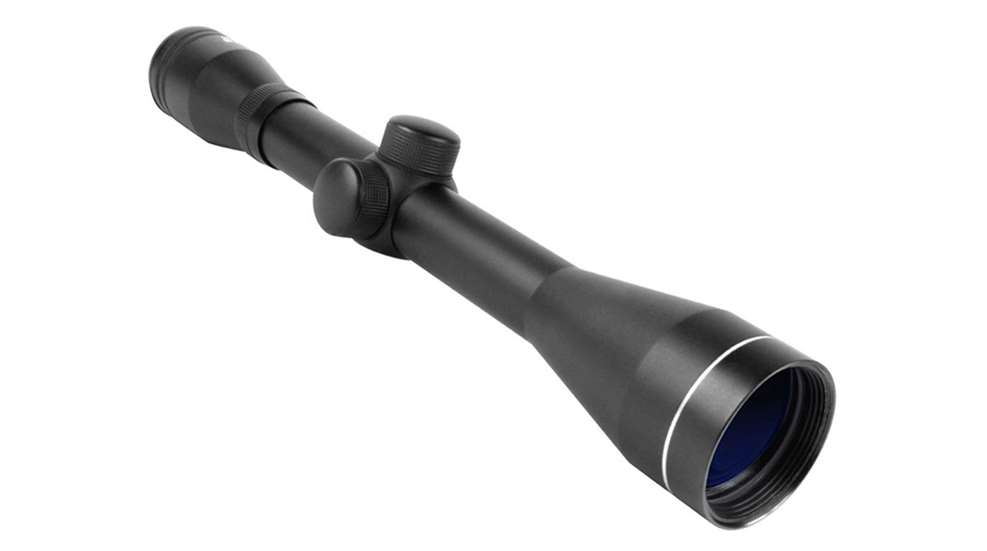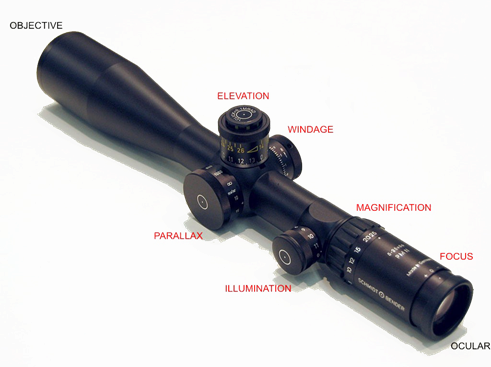
Many of today’s shooters put as much thought in their sighting systems or optics as they do their firearm. When it comes to rifles, telegraphic scopes are the number one choice for hunters, target shooters, and long-range shooting enthusiasts. Pairing the right rifle and scope takes some knowledge so that your rifle is neither under powered nor overpowered.
Telegraphic scopes magnify the field of view (FoV), which is the observable world at any given time. In optics, the observable world is determined by the magnification of the scope. The magnification of a scope is indicated by a series of numbers.

The first things shooters should know about optics are the parts of the scope. The parts of the standard scope are (1) eyepiece, (2) magnification ring (for adjustable scopes), (3) windage adjustment knob, (4) elevation adjustment knob, (5) parallax focus knob (on some scopes), and (6) objective lens. Knowing the terminology is the first step in understanding and deciding which is the best scope for your firearm.
Eyepiece: The lens nearest the eye that you look through
Eye Relief: The proper distance from the eyepiece of the optic and the shooter’s eye that fills the entire field of view with the target
Elevation Adjustment: The dial located on top of a scope that moves the impact of the bullet up or down
Field of View (FoV): What is seen or observable through the scope at any given time
Magnification Ring: A rotating ring or adjustment that selects the desired magnification for a variable scope
Main Tube Diameter: The diameter of the tube or body of the scope normally 1-inch, 30mm, 34mm, or 35mm in which scopes rings are used to secure to the rifle
Objective Lens: The lens furthest from the eye piece, closest to the target
Parallax: The point of impact that slightly varies in relation to the shooter’s eye and the scope
Parallax Adjustment: The dial located on the side of a scope that stabilizes the parallax as viewed through the scope
Reticle: The crosshairs or other aiming lines seen through the scope at a target
Turret: The round body that the scope’s elevation, windage, parallax, or other adjusted are affixed to
Windage Adjustment: The dial located on the side of a scope that moves the point of impact of the bullet right or left
There are three classifications of telegraphic scopes: fixed power scopes: variable power scopes; and quick acquisition scopes.
Fixed Power Scopes
A fixed power scopes has only one magnification. Since it only has one power, there is no magnification adjustment ring. There is usually only a windage and elevation adjustment.

Variable Power Scopes
Variable power scopes have a range of magnification that the shooter selects. The shooter looks through the eye piece while turning the magnification ring to the desired power.

Quick Acquisition Scopes
Quick acquisition scopes are designed to pick up the target quickly when acquiring a target. These scopes are usually low variable power. Most quick acquisition scopes are variable 1.5-power to 6-power. This type of scope is used for tactical purposes or hunting dangerous game. The reason these types of scope are low power is so that the shooter has a wide field of view to quickly pick up dangerous threats.

Depending on the scope, magnification or field of view is represented by either one, two, or three numbers. The simplest designation is a fixed (single) magnification. For example, a scope with one magnification might be a 3-power or 4-power. These would be designated as 3X or 4X. The next type of designations are variable scopes or ones that have a range of magnification. For example, these would be designated as 3-9 or 4-12. These scopes would have an adjustable magnification range of 3-power to 9-power and 4-power to 12-power respectively. The last type of scope designation would the optic’s magnification range and the size in millimeters of the objective lens. For example, the scope’s designation might be 3-9X40 or 4-12X50. These numbers indicate an adjustable range of 3-power to 9-power with an objective lens on 40mm and a 4-power to 12-power with an objective lens of 50mm.
There are several things to keep in mind when selecting the proper scope for your rifle. The first thing to keep in mind is the size of the objective lens. This is the lens furthest away from the eye piece. The size of objective lens includes, but is not limited to 24mm, 30mm, 40mm, 44mm, and 50mm. Regarding objective lenses, size does matter.

The larger the objective lens, the more light it allows to enter into the scope. Scopes with 50mm objective lenses allows more light than a 44mm. A 44mm lets in more light than a 40mm. A 40 mm lets in more light than a 30mm, and so on.
This is important in low light conditions. It allows you to see better at sunrise and sunset. For example, while at the beginning or end of legal shooting hours often times those beginning or ending few minutes may increase difficulty when trying to see your target. Without the proper scope for low light conditions, even though it might be legal to take that shot, it may not be very ethical if you are unable to properly identify your target with certainty, with a smaller objective lens.

The second thing to remember is how to use higher magnifications. Most shooters cannot hold a rifle steady enough to shoot a target over 9-power magnification. This is why most variable power scopes are 3-9X. But you may ask: Why do shooters have the option of variable power scopes up to 14-power or more? For example, a hunter might have a 4-14X50mm variable power scope. The hunter might view a target with the higher magnification but adjust it down to 9-power to take the shot.
Choosing the right optic for your scope is very important. This is because your accuracy depends on how well you can see your target. I often see someone struggling with their shot placement at the gun range. They seem to be unable to get a desirable shot grouping. Upon further investigation, I see an individual with a $1,200 rifle with a $200 scope. A quality scope is just as important as a quality rifle.
If I had a choice between a high-quality rifle and an inexpensive scope, or an inexpensive rifle and a high-quality scope, I would opt for the latter. That is just how important the scope is in a rifle/scope combination. Remember, you cannot hit what you cannot see!















































